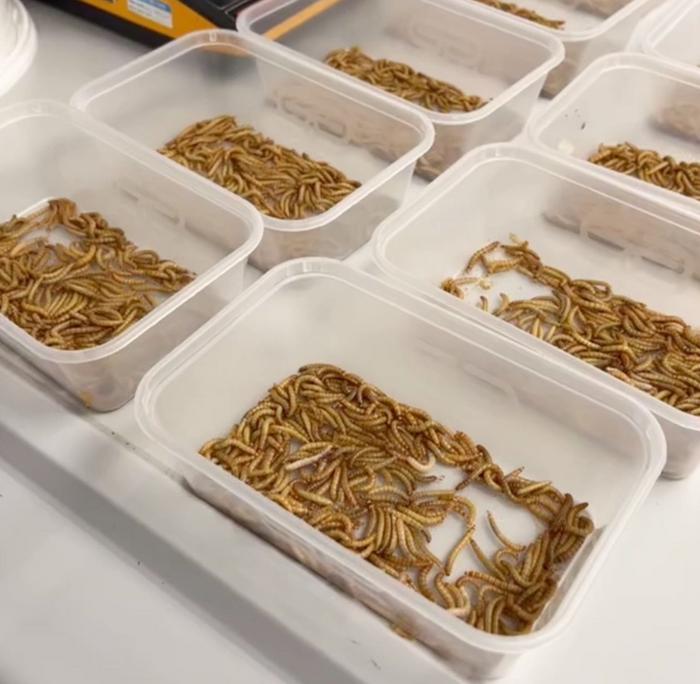Insects have long been hailed as the future of sustainable protein, with many touting their ability to thrive on unconventional diets, including plastic waste, transforming this into a nutritious biomass. However, recent groundbreaking research from the University of Nottingham challenges some of these optimistic assumptions, specifically in the case of the yellow mealworm, Tenebrio molitor. This study rigorously examines the nutritional requirements of these larvae, revealing a critical need for a baseline level of dietary protein to ensure not only survival but healthy growth and successful development through their life cycle.
The allure of insects as a sustainable food source stems primarily from their efficient feed-to-protein conversion ratio and low environmental footprint compared to traditional livestock. Mealworms, in particular, have attracted attention for their versatility in consuming a wide range of organic materials including agricultural by-products and even certain plastics like polystyrene. Nevertheless, the question remained: can mealworms truly convert non-protein substrates into a nutritionally complete product suitable for large-scale use as human food or animal feed?
To address this, Nottingham’s team conducted meticulous dietary experiments, feeding various groups of mealworms diets with carefully controlled nutrient levels. These ranged from protein-rich formulations to those devoid of protein but containing other nitrogenous, non-protein sources. The results were unmistakable: while mealworms can survive on protein-free diets for some time, they fail to exhibit normal growth patterns and crucially do not enter pupation, the transformative stage vital for reproduction and sustainable cultivation.
.adsslot_DOykxAva6n{ width:728px !important; height:90px !important; }
@media (max-width:1199px) { .adsslot_DOykxAva6n{ width:468px !important; height:60px !important; } }
@media (max-width:767px) { .adsslot_DOykxAva6n{ width:320px !important; height:50px !important; } }
ADVERTISEMENT
The study highlights that the larvae’s nutritional composition, predominantly protein, fat, and fiber, shifts significantly depending on the quality of their diet. The protein content not only underpins physical growth but also drives essential biochemical and developmental processes. Without adequate protein, the larvae’s metabolism cannot support the complex physiological transformations necessary to advance from larval stages into adulthood. This negates the earlier notion that plastic or other non-protein substrates could be a stand-alone feed source for commercial production.
Moreover, Professor Tim Parr, an expert in Nutritional Biochemistry involved in the study, pointed out the broader impact for industrial-scale insect farming. Understanding minimum nutritional thresholds is foundational for streamlining cost-effective, sustainable mealworm production. By delineating the precise dietary requirements that enable maximal growth and reproductive capacity, producers can tailor feeds that balance economic feasibility with nutritional output. This marks an important advance towards the commercial scalability of insect-based protein.
The study’s methodology involved controlled feeding trials where mealworm groups were monitored over extended periods, meticulously recording growth metrics, pupation rates, and larval biochemical composition. Diets completely lacking protein led to stunted growth and prevented pupation, whereas even modest protein inclusion restored these essential biological functions. These findings underscore that nitrogen in non-protein form cannot substitute for the complex amino acid compositions found in true protein sources.
This research carries significant ramifications for the broader effort to develop insect protein as a sustainable alternative to conventional agriculture. While incorporating agricultural waste and low-value biomass remains promising, the reliance on substrates devoid of true protein – such as certain plastics – must be reconsidered. The biochemical limitations illuminated here demonstrate that nutrient quality, not just quantity or survival, governs practical usability in food and feed applications.
In addition to refining feedstock choices, this research also invites innovation in designing synthetic or blended insect diets that meet exact nutritional standards. Precision nutrition approaches could accelerate the adoption of insect farming by guaranteeing consistent insect quality and optimizing growth cycles, thereby reducing costs and environmental impacts. This aligns with global efforts to diversify protein sources amid increasing population and environmental challenges.
The nutritional ecology of mealworms, as detailed in this study, also invites further investigation into metabolic pathways governing protein assimilation and conversion efficiency. Deciphering these molecular mechanisms can reveal targets for genetic or environmental modulation to enhance insect productivity. Such scientific endeavors could potentially unlock new pathways for leveraging low-grade biomass more effectively within the constraints of insect physiology.
Ultimately, this research underscores a fundamental principle of insect farming: nutritional sufficiency, not novelty of substrate, determines success. The promise of mealworms simultaneously rests on sustainable sourcing and meeting essential biological requirements. With these findings, the path toward scalable, nutritious, and truly sustainable insect protein production becomes clearer and more grounded in evidence.
Subject of Research: Not applicable
Article Title: Effects of replacing protein with non-protein nitrogen sources on growth, development and composition of Tenebrio molitor larvae
News Publication Date: Not explicitly provided (Article publication date: 11-Jun-2025)
Web References:
Journal link: https://brill.com/view/journals/jiff/aop/article-10.1163-23524588-bja10241/article-10.1163-23524588-bja10241.xml
DOI: http://dx.doi.org/10.1163/23524588-bja10241
Related Guardian article on mealworms as food source: https://www.theguardian.com/environment/2021/jan/13/yellow-mealworm-safe-for-humans-to-eat-says-eu-food-safety-agency
Article on mealworms fed on polystyrene: https://theconversation.com/plastic-eating-insect-discovered-in-kenya-242787
References:
University of Nottingham research team, Journal of Insects as Food and Feed, June 2025.
Image Credits: University of Nottingham
Keywords: Mealworms, Tenebrio molitor, protein requirement, insect nutrition, sustainable protein, insect farming, pupation, insect feed, plastic biodegradation, alternative protein sources.
Tags: alternative feeding strategies for mealwormschallenges in insect-based food sourcesconverting plastic waste into fooddietary protein and insect developmentenvironmental impact of mealwormsinsect protein conversion efficiencyinsects in food sustainabilitymealworms as sustainable protein sourcemealworms diet and growthnutritional requirements of mealwormsprotein-rich diets for mealwormsTenebrio molitor research study





